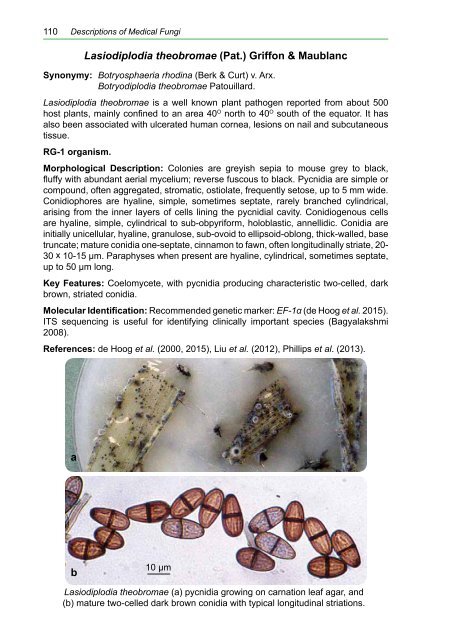DESCRIPTIONS OF MEDICAL FUNGI
fungus3-book
fungus3-book
You also want an ePaper? Increase the reach of your titles
YUMPU automatically turns print PDFs into web optimized ePapers that Google loves.
110<br />
Descriptions of Medical Fungi<br />
Lasiodiplodia theobromae (Pat.) Griffon & Maublanc<br />
Synonymy: Botryosphaeria rhodina (Berk & Curt) v. Arx.<br />
Botryodiplodia theobromae Patouillard.<br />
Lasiodiplodia theobromae is a well known plant pathogen reported from about 500<br />
host plants, mainly confined to an area 40 O north to 40 O south of the equator. It has<br />
also been associated with ulcerated human cornea, lesions on nail and subcutaneous<br />
tissue.<br />
RG-1 organism.<br />
Morphological Description: Colonies are greyish sepia to mouse grey to black,<br />
fluffy with abundant aerial mycelium; reverse fuscous to black. Pycnidia are simple or<br />
compound, often aggregated, stromatic, ostiolate, frequently setose, up to 5 mm wide.<br />
Conidiophores are hyaline, simple, sometimes septate, rarely branched cylindrical,<br />
arising from the inner layers of cells lining the pycnidial cavity. Conidiogenous cells<br />
are hyaline, simple, cylindrical to sub-obpyriform, holoblastic, annellidic. Conidia are<br />
initially unicellular, hyaline, granulose, sub-ovoid to ellipsoid-oblong, thick-walled, base<br />
truncate; mature conidia one-septate, cinnamon to fawn, often longitudinally striate, 20-<br />
30 x 10-15 µm. Paraphyses when present are hyaline, cylindrical, sometimes septate,<br />
up to 50 µm long.<br />
Key Features: Coelomycete, with pycnidia producing characteristic two-celled, dark<br />
brown, striated conidia.<br />
Molecular Identification: Recommended genetic marker: EF-1α (de Hoog et al. 2015).<br />
ITS sequencing is useful for identifying clinically important species (Bagyalakshmi<br />
2008).<br />
References: de Hoog et al. (2000, 2015), Liu et al. (2012), Phillips et al. (2013).<br />
a<br />
b<br />
10 µm<br />
Lasiodiplodia theobromae (a) pycnidia growing on carnation leaf agar, and<br />
(b) mature two-celled dark brown conidia with typical longitudinal striations.





